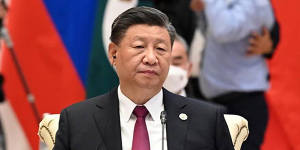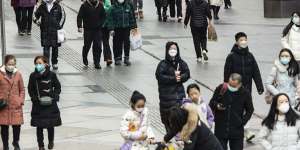Actually,it’s not so much helicopter money,or the People’s Bank of China printing money to distribute directly into consumers’ pockets,but the absence of any large-scale fiscal transfers to boost household incomes and spur consumption.

Beijing hasn’t announced any funding of its own for it latest economic strategy.AP
What was in the host of micro measures China’s State Council unveiled on Monday was a hotchpotch series of subsidies directed at “light” industries,from furniture to batteries,the removal of government measures that restrict consumption,some modest and targeted infrastructure investment and reduced prices for tourist sites.
In effect,the measures are targeted more at the supply side of the economy,aimed at reducing prices in the hope that might boost consumption,rather than at the demand side and directly at households that are displaying signs of increasing risk aversion.
As (by China’s standards) the authorities have shown a reluctance to embark of the big infrastructure-based stimulus programs of the past,with the wasteful spending and overcapacity they generated,or to inject cash directly into households. The latter might be because they believe that overly-indebted and cautious households would save any government largesse rather than spend it.
That aversion to large-scale stimulus programs,however,means the government is struggling to break the cycle of waning consumer confidence and kick-start the increased consumption it is seeking,and which China needs,to take up the slack from exports that have weakened in line with the global economic slowdown.
That reduced global growth has left China’s factories,which scaled up to meet the dramatic surge in Western consumer demand during the pandemic,with excess capacity.
With signs of deflation setting in — factory prices have been falling for months and consumer prices are flatlining – there is a risk,albeit that it isn’t the probable outcome,of China suffering a variation of the deflationary trap into which Japan fell into in the 1990s and from which.
The weak consumer spending,shrinking factory output and record youth unemployment means that is a risk the authorities have to avoid. At some point,they’ll have to do more to boost consumption,stabilise their property markets and restructure the financing of the overly-indebted local governments that are key elements of China’s economic structures.
Fixing local government finances,which are being asphyxiated by the combination of extreme indebtedness and the loss of their major source of income,property sales,ought to be a priority for Beijing if it is to address the obvious weakness in China’s financial system.
Local governments are key conduits for China’s economic policies,but also for the Communist Party’s control over the provinces.

Xi Jinping’s government is desperate for its consumers to start spending.Bloomberg
In the current circumstances,local governments will play important roles in the success,or otherwise,of the measures the authorities have announced. At present they probably represent a brake on growth,not a potential accelerant.
The efficacy of many of the most recent initiatives announced by the central authorities – more shopping malls in remote areas,neighbourhood redevelopments,more charging infrastructure for electric vehicles and incentives for car sales – appear reliant on those local governments for their funding and implementation.
Beijing hasn’t announced any funding of its own for it latest economic strategy,relying on attracting investment from the cash-strapped local governments and,very significantly,from the private sector it has been battering for more than two years.
Beijing has also made a concerted effort in recent weeks to woo foreign investors,although the raids on the consultancies foreign firms rely on for due diligence,the barring of access to the data needed for that due diligence and the increased tensions between China and the West have made external investment in China more problematic than it once was.
The lack of the “shock and awe” style of response to the economic slowdown that Beijing has deployed in the past might be because the authorities are convinced that this economic episode is transitory, and that the economy will – as has happened in other major economies as the impact of the pandemic has waned– gradually gather momentum as the year progresses without the need for more dramatic interventions.
The latest data,however,isn’t encouraging. On Monday the National Bureau of Statistics released purchasing managers indices that showed manufacturing activity contracted for the fourth successive month in July. Growth in services slowed to levels last seen in December last year,when the COVID-driven lockdowns ended,although it remains modestly positive. The readings on employment,construction and exports have also been weak.
House prices continue to fall,and measures to help fund the completion of incomplete developments and lower borrowing costs for buyers aren’t going to kickstart a key sector within the economy if buyers are in risk-aversion mode.
How Beijing manages the efforts to revive the faltering economy matters,not just for China’s people and businesses,but for the rest of the world and commodity producers,like Australia,in particular.
The big shift in strategy,from restricting private sector activity to embracing it and creating a level playing field with state-owned enterprises,was a sensible and necessary move.
But after several years of Xi Jinping’s destabilising crackdowns on private enterprises,including China’s most dynamic private businesses,it will take time and Beijing’s actions for entrepreneurs to regain trust and confidence in the central authorities.
How Beijing manages the efforts to revive the faltering economy matters,not just for China’s people and businesses,but for the rest of the world and commodity producers,,in particular.
Deflation in China might mean a lower cost of goods for consumers and businesses elsewhere but overcapacity in China’s industries and a flood of low-cost exports would also undermine businesses and investment elsewhere while reducing China’s demand for the foreign-sourced raw materials (like iron ore or LNG) and goods that have powered its economic growth over recent decades.
It’s not in anyone’s interests for China’s economy to continue to splutter,let alone for it to slip into the kind of deflationary spiral that overwhelmed Japan.
It needs to devise a mechanism for igniting domestic consumption and buying the growth and time that would enable it to address some of the structural vulnerabilities – the levels of debt in its economy,the levels of unemployment,the levels of unproductive investment,the still-reeling property sector and the challenges of a declining population – that its previous stellar growth rates have cloaked.
The Business Briefing newsletter delivers major stories,exclusive coverage and expert opinion..